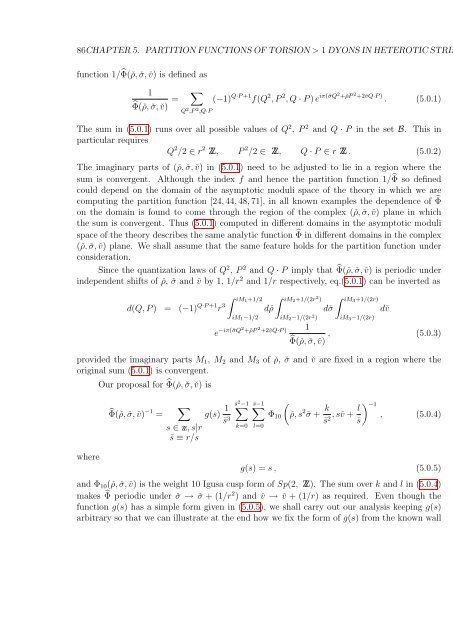PHYS08200604018 Shamik Banerjee - Homi Bhabha National ...
PHYS08200604018 Shamik Banerjee - Homi Bhabha National ...
PHYS08200604018 Shamik Banerjee - Homi Bhabha National ...
You also want an ePaper? Increase the reach of your titles
YUMPU automatically turns print PDFs into web optimized ePapers that Google loves.
86CHAPTER 5. PARTITION FUNCTIONS OF TORSION > 1 DYONS IN HETEROTIC STRIN<br />
function 1/̂Φ(ˇρ, ˇσ, ˇv) is defined as<br />
1<br />
̂Φ(ˇρ, ˇσ, ˇv) =<br />
∑<br />
Q 2 ,P 2 ,Q·P<br />
(−1) Q·P +1 f(Q 2 , P 2 , Q · P ) e iπ(ˇσQ2 +ˇρP 2 +2ˇvQ·P ) . (5.0.1)<br />
The sum in (5.0.1) runs over all possible values of Q 2 , P 2 and Q · P in the set B. This in<br />
particular requires<br />
Q 2 /2 ∈ r 2 Z, P 2 /2 ∈ Z, Q · P ∈ r Z . (5.0.2)<br />
The imaginary parts of (ˇρ, ˇσ, ˇv) in (5.0.1) need to be adjusted to lie in a region where the<br />
sum is convergent. Although the index f and hence the partition function 1/̂Φ so defined<br />
could depend on the domain of the asymptotic moduli space of the theory in which we are<br />
computing the partition function [24, 44, 48, 71], in all known examples the dependence of ̂Φ<br />
on the domain is found to come through the region of the complex (ˇρ, ˇσ, ˇv) plane in which<br />
the sum is convergent. Thus (5.0.1) computed in different domains in the asymptotic moduli<br />
space of the theory describes the same analytic function ̂Φ in different domains in the complex<br />
(ˇρ, ˇσ, ˇv) plane. We shall assume that the same feature holds for the partition function under<br />
consideration.<br />
Since the quantization laws of Q 2 , P 2 and Q · P imply that ̂Φ(ˇρ, ˇσ, ˇv) is periodic under<br />
independent shifts of ˇρ, ˇσ and ˇv by 1, 1/r 2 and 1/r respectively, eq.(5.0.1) can be inverted as<br />
∫ iM1 +1/2<br />
d(Q, P ) = (−1) Q·P +1 r 3 dˇρ<br />
iM 1 −1/2<br />
∫ iM2 +1/(2r 2 )<br />
iM 2 −1/(2r 2 )<br />
dˇσ<br />
∫ iM3 +1/(2r)<br />
iM 3 −1/(2r)<br />
e −iπ(ˇσQ2 +ˇρP 2 +2ˇvQ·P ) 1<br />
̂Φ(ˇρ, ˇσ, ˇv) , (5.0.3)<br />
provided the imaginary parts M 1 , M 2 and M 3 of ˇρ, ˇσ and ˇv are fixed in a region where the<br />
original sum (5.0.1) is convergent.<br />
where<br />
Our proposal for ̂Φ(ˇρ, ˇσ, ˇv) is<br />
̂Φ(ˇρ, ˇσ, ˇv) −1 =<br />
∑<br />
s ∈ zz, s|r<br />
¯s ≡ r/s<br />
g(s) 1¯s 3<br />
¯s<br />
∑<br />
2 −1<br />
k=0<br />
∑¯s−1<br />
l=0<br />
dˇv<br />
Φ 10<br />
(<br />
ˇρ, s 2ˇσ + k¯s 2 , sˇv + l¯s) −1<br />
, (5.0.4)<br />
g(s) = s , (5.0.5)<br />
and Φ 10 (ˇρ, ˇσ, ˇv) is the weight 10 Igusa cusp form of Sp(2, Z). The sum over k and l in (5.0.4)<br />
makes ̂Φ periodic under ˇσ → ˇσ + (1/r 2 ) and ˇv → ˇv + (1/r) as required. Even though the<br />
function g(s) has a simple form given in (5.0.5), we shall carry out our analysis keeping g(s)<br />
arbitrary so that we can illustrate at the end how we fix the form of g(s) from the known wall

















